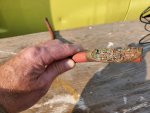Reno_master
New member
I have a retired ambulance (2002 E-450). It has a battery separator/isolator under the passenger seat accessed via the door well (i.e. where you put your foot to climb into the van). A 2 position battery switch is behind the passenger seat base. It has two positions: OEM ONLY and OEM PLUS CONVERSION.
My problem is that the OEM batteries (engine and rail) are completely dead yet the AUX (Conversion) are always fully charged. All 4 batteries are the same and new within the last year. I suspect that something is wrong with the separator/Isolator. Do separators go bad? Are there fusable links in there.
I am including a picture of the separator and what wires are attached there.
The system used to work just fine. All the batteries are grounded.
The legend for the wires:
1. Separator switch
2. AUX bank "+"
3. OEM bank "+"
4. Instrument panel ( ammeter and voltage)
5. Alternator output.
6. OEM bank "+“
7. Separator switch.
Is my logic sound? Had anyone taken these isolators apart? Do they fail in the manner I'm describing? Any insight would be appreciated.
Thanks.
My problem is that the OEM batteries (engine and rail) are completely dead yet the AUX (Conversion) are always fully charged. All 4 batteries are the same and new within the last year. I suspect that something is wrong with the separator/Isolator. Do separators go bad? Are there fusable links in there.
I am including a picture of the separator and what wires are attached there.
The system used to work just fine. All the batteries are grounded.
The legend for the wires:
1. Separator switch
2. AUX bank "+"
3. OEM bank "+"
4. Instrument panel ( ammeter and voltage)
5. Alternator output.
6. OEM bank "+“
7. Separator switch.
Is my logic sound? Had anyone taken these isolators apart? Do they fail in the manner I'm describing? Any insight would be appreciated.
Thanks.





